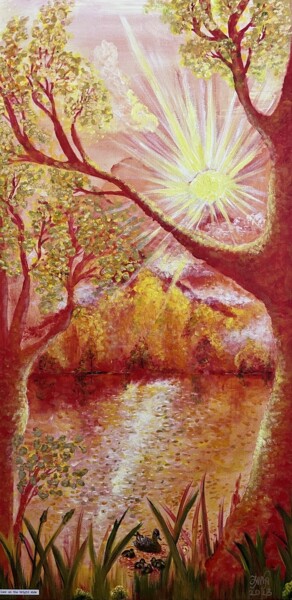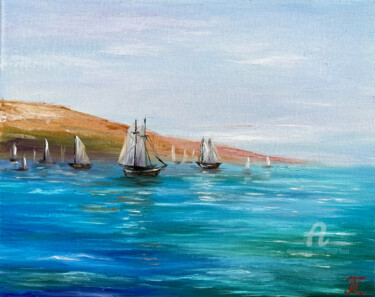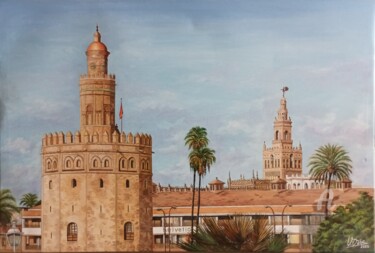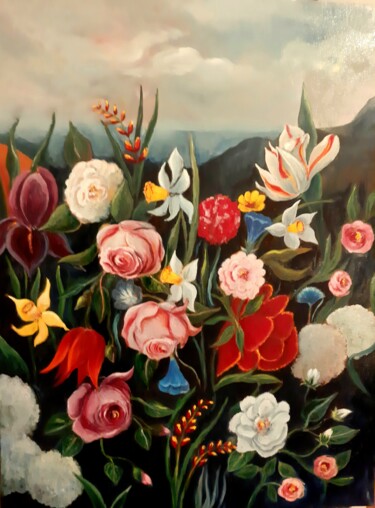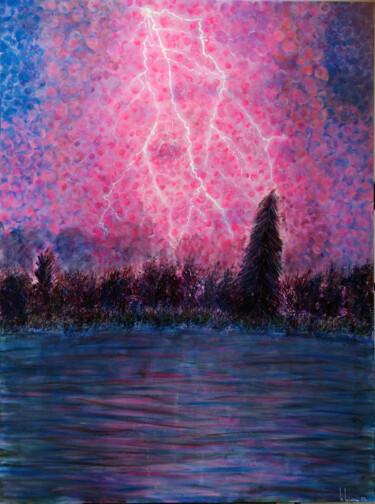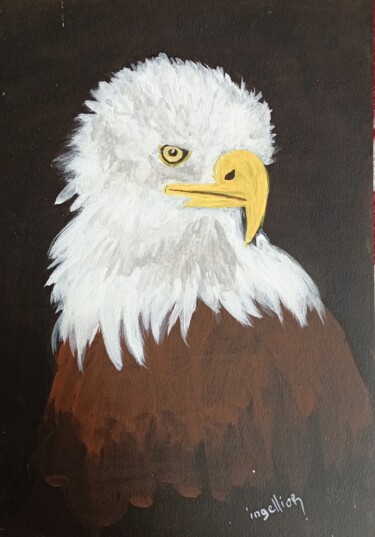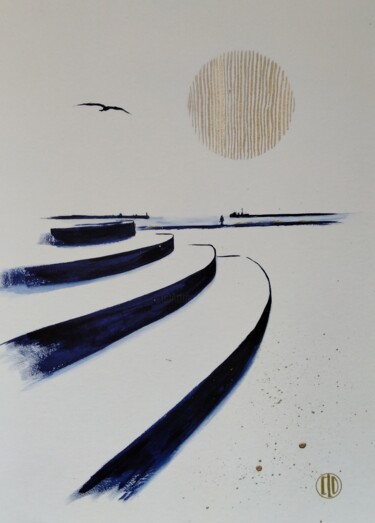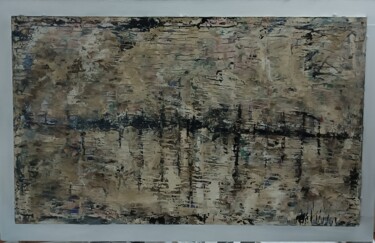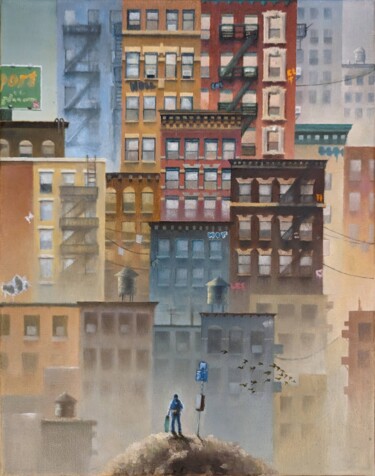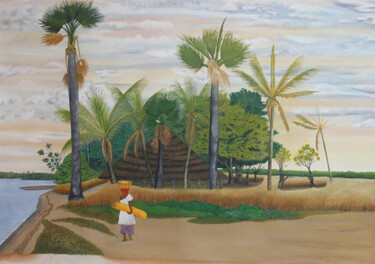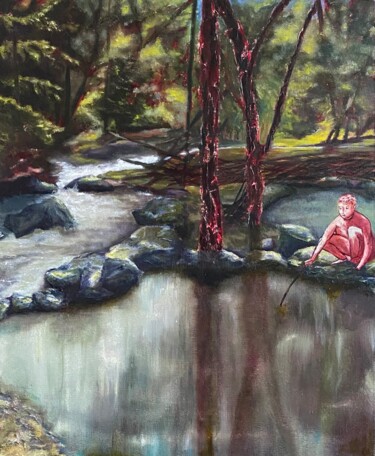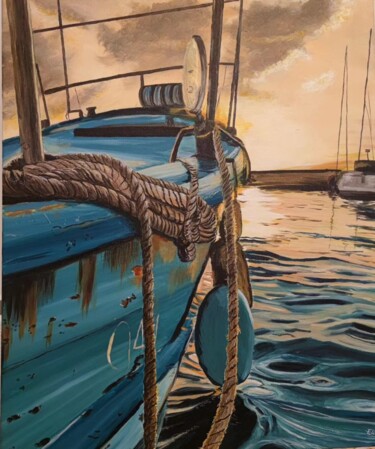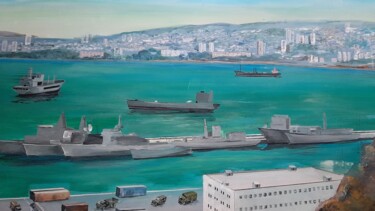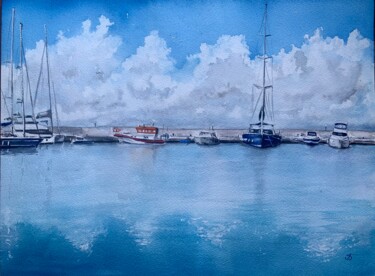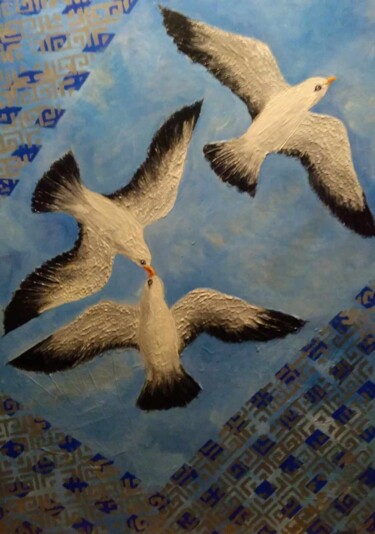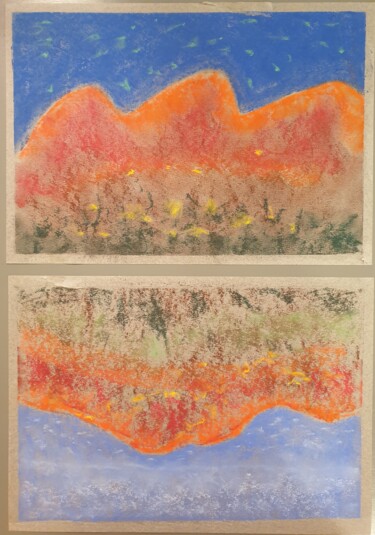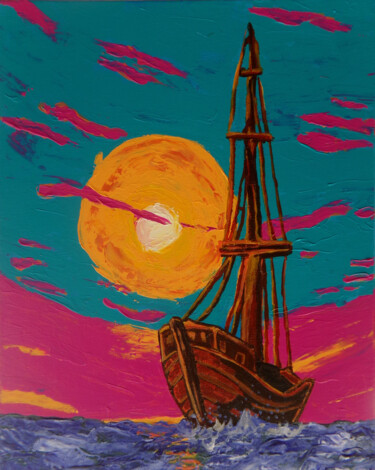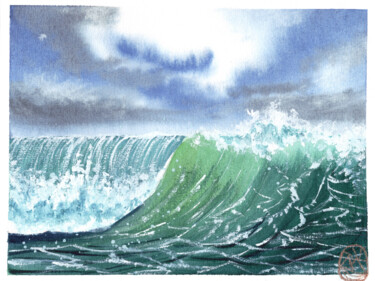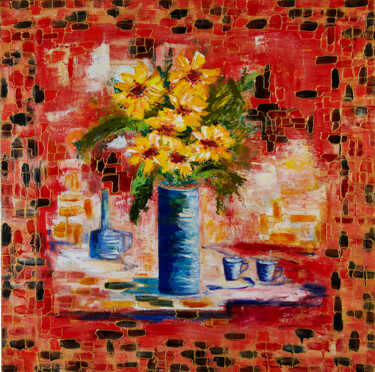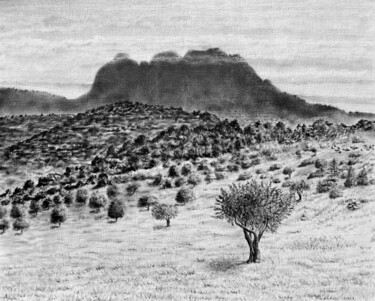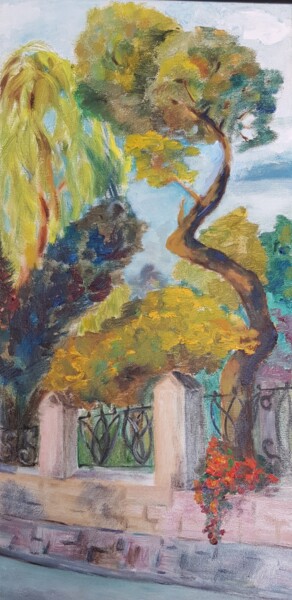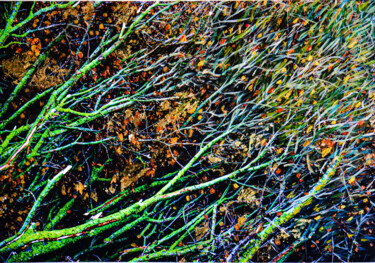988 Pinturas originales para la venta:
¿Cómo definir estilo Arte de la tierra ?
What are land art paintings?
Land art paintings are inspired by land art or Eart art. Earth art, which is also called Land art or Earthworks, is mostly an American movement that uses the natural landscape to make structures, art forms, and sculptures that are only meant to be seen in one place. The movement grew out of Conceptualism and Minimalism. The start of the environmental movement and the widespread commercialization of American art in the late 1960s influenced ideas and works that were, to varying degrees, separate from the art market. In addition to the size and simplicity of Minimalist objects, the artists were interested in Arte Povera's use of simple, everyday materials and Joseph Beuys' "social sculptures," which encouraged performance and creativity in any setting.
Insight into land art
Land art is a style of art that started to develop in the United States in the late 1960s. It is also called environmental art, Earth art, and sometimes Earthworks. After the peak of the Minimalism art movement, Land Art became part of the larger Conceptual art movement that was going on at the same time. This was a time when the traditional and formal rules of art making were questioned. Land art was made to make people think more about how humans affect the natural environment.
Land artists pushed the limits of art by the things they made and where they put them. They often changed the landscape directly to make their sculptures and installations. Most of the time, these works of art were carved out of the land itself or made as Earthwork art with natural materials that were available to the artist. Soil, plants, rocks, gravel, stones, twigs, and water that were usually found on-site were popular. Using these materials showed respect for the uniqueness of the site.
Land art was often made in remote areas that were far from cities and hard to get to. It was heavily influenced by ancient works like Stonehenge and the Pyramids. These installations were left to break down naturally in nature without any protection from the elements. The fact that they eventually fell apart showed how temporary they were, which was a stark contrast to art that was usually kept safe in galleries and other places where it was watched.
The Earth art that was made brought the idea of "site specificity" to the art world. Because people couldn't always see these sculptures, the artists were often the only ones who knew they existed. Because of this, artists would usually take pictures of their work and put those pictures in art galleries instead of the real works.
As the Land Art movement protested the ruthless commercialization of art in the 1960s, this change in location called into question the idea that art is just something to look at. These works talked about going back to nature, which led to the growth of the environmental movement, which saw Earth as the real home of people. So, Land artists started making sculptures out of Earth that reflected this ideal and showed that they didn't want to live in cities at all.
Museums and galleries, which were the usual places for artists to work, were no longer used. This gave artists the freedom they needed to make large sculptures that were too big to be moved around. Because the work was hard to get to, it was shown in galleries through photographs and maps.
Land Art artists were heavily influenced by other modern art movements like De Stijl, Cubism, and Minimalism. Many of the same artists were also involved in Minimal Art and Conceptual Art. Also, Land artists were attracted to parts of the Arte Povera movement, like how simple it was and how it used simple, everyday materials in its art.
Land artists had to use the system they hated to pay for their expensive ideas so they could make sculptures and installations outside of traditional gallery and museum spaces. Large landscape installations often required buying land and using earth-moving tools. Rich patrons and private foundations often paid for these crazy and complicated projects.
The American artist Robert Smithson may have been one of the most important people to start this movement. His 1970 piece Spiral Jetty is the most famous Land Art sculpture to date. Smithson put rocks, algae, and dirt in the shape of a spiral to make a 1500-foot jetty that went into the Great Salt Lake in Utah, USA. This work is still there today and can be seen sometimes when the water levels are low.
But Smithson's sudden death in 1973 and the unexpected economic downturn in the mid-1970s, which stopped all funding, put an end to the movement. The Land Art movement started to die out after it lost its most important leader. Only a small number of artists still made art that followed the movement's rules. Slowly, Land Art became a normal part of public art, and its name was mistakenly used to describe any kind of art that was in nature.
Even though the movement started early on, art based on these ideas didn't come out until the end of the 1960s. Earthworks and Earth Art were the names of the first Land Art shows that were recorded. They showed works by well-known Land artists. The works in these shows were shown at the Candace Dawn Gallery in New York and at Cornell University's Andrew Dickson White Museum of Art.
Land Art is seen as one of the most experimental art movements in Western history. Its rejection of traditional art spaces helped it establish itself as a valid art movement. Land art changed what people thought art was and questioned whether it was just something to look at and sell for money. Robert Smithson, Richard Long, Michael Heizer, Nancy Holt, Walter De Maria, Agnes Denes, Dennis Oppenheim, and Andy Goldsworthy are all well-known Land Artists of the present day.
What are the characteristics of land art?
In the works that were made as part of the Land Art movement, the idea of something being temporary was emphasized. Most Earth art didn't focus on the beauty and aesthetics that were usually associated with art, because these pieces were made to show that the movement didn't want art to become a commodity. So, the main thing about Land Art was that sculptures weren't put up in galleries or other places where most people go to see art. Instead, they were put up in remote places that most people couldn't get to.
Land Art was influenced by the way the art market was becoming more and more commercialized. Artists were inspired to make confusing works that couldn't be sold as objects. Instead, Land Art was known for being temporary because the materials used in the works were meant to decay, melt, wither, or fall apart. This meant that the artworks could only be around for a short time.
The fact that these works were photographed further set Land Art apart from the Conceptual Art movement that came before it, since taking photos was a key part of Conceptual Art. Without photos, there would be no proof that the work existed. In fact, artists often just show the photos at art galleries and museums. But these traditional viewing spaces took advantage of the fact that these works had to be photographed, which brought a commercial element back into the sculptures. The most important part of Land Art was often its stillness and location in a site-specific setting, but it was also important to plan and take pictures of how ideas were put into action and the final results. This made it possible for these earthworks to be shown in galleries even though they were in different and far away places. So, a link was made between the sculptures and their photos, as the public relied on this two-dimensional form of media to show how big the sculptures were.
Land art was defined by the fact that sculptures and installations were made from natural materials that were usually found at the site of development. These works of art were also made outside in different places so that they could interact with nature in different ways. Similar to how the ready-made changed what a work of art could be, Land Art changed what a work of art could be by expanding the types of materials and places that could be used.
Land Art was able to get away from the idea that museums and galleries were the best places to show and see art because social protest and political unrest in the 1960s and 1970s gave the movement momentum. Also, the rise of the environmental movement was a big factor in the success and growth of Land Art in the years that followed. Both movements rejected urbanism and the important choices it offered in favor of a utopian view of Earth that saw the planet as the best place for people to live.
During the Land Art movement, some of the more complicated projects had different ideas behind them. However, all of the installations showed a great respect for the meditative quality of long periods of time and a vital sense of adventure. This was shown by the art that was made out in nature and then left to break down and wear away in its own time.
In order to sort the different kinds of Land Art that have been made, the works can be put into two categories: "Site" and "Nonsite." These categories are based on the theoretical differences that exist in the physical context of the work. "Site" works were usually pieces that could only be seen in a certain place because they were connected to their outdoor bases in a way that couldn't be separated. "Nonsite" pieces were works that could be shown inside, like in a gallery.
But both "Site" and "Nonsite" works, no matter what they were called or where they were seen, were Earthworks because of the way the materials used to make them broke down over time. Artists used to think that keeping art in places like galleries was a sign of arrogance because the works would lose their original meaning. However, after the recession of the mid-1970s, many artists had to change their ideas. So, many Land artists changed the way they made art to fit into formal and gallery spaces.
Summary of the key concepts of land art
For Earthworks, the best materials were ones that could be taken from nature, like stones, water, gravel, and soil. Earth artists left their structures open to the weather because they were inspired by ancient art like Stonehenge. Because of this, the works were temporary and would eventually fall apart. This put them outside of the mainstream, where art was usually kept safe and protected in controlled environments.
Earth artists often used materials that were available at the site where they built and put their works. This was done to show respect for the site. Places were often picked for specific reasons. Robert Smithson, for example, chose broken places to use in his art to show rebirth and renewal. Earth art brought the idea of "site-specificity" to the art world. Again, this put the artists on the cutting edge because their pieces often needed large, open spaces. This meant that many of their works were not available to the average viewer, which made people question the point of art as something to look at.
Earth art practice was defined by the fact that it didn't use traditional gallery and museum spaces. By making their art outside of these institutions, Earth artists pushed back against the idea that art was a commodity in these places, again challenging the idea that art is something that can be bought and sold for money.
Forms of Land Art
Land art was a protest against the "ruthless commercialization" of art in the 1960s and 1970s. [needs citation] During this time, people who did land art didn't want to do art in a museum or gallery. Instead, they made huge landscape projects that were too big for traditional sculptures to move and too big for the commercial art market. Photographs of these projects were often shown in normal gallery spaces, though. Land art was influenced by minimal art, conceptual art, and modern art movements like De Stijl, Cubism, Minimalism, and the work of Constantin Brancuşi and Joseph Beuys. Many of the artists who were involved in land art had also done minimal art and conceptual art. Some people think that Isamu Noguchi's design for Contoured Playground in New York City in 1941 was an important early piece of land art, even though the artist never called his work "land art" but just "sculpture." Many works of land art, landscape architecture, and environmental sculpture made after he died show his influence.
Alan Sonfist took a different way to work with nature and culture by bringing back historical nature and eco-friendly art to New York City. His most inspiring work is Time Landscape, a forest he planted in New York City with trees from all over the world. He also made other Time Landscapes all over the world, like Circles of Time in Florence, Italy, which shows how the land has been used in the past, and most recently at the deCordova Sculpture Park and Museum outside of Boston.
In 1969, art critic Barbara Rose wrote in Artforum that he was unhappy with how art was being sold and how it was only being shown in galleries. In 1967, art critic Grace Glueck wrote in The New York Times that the first Earthwork was done at the Skowhegan School of Painting and Sculpture by Douglas Leichter and Richard Saba. Land art popped up all of a sudden in 1968, when most artists were in their late 20s. It was a response by a generation of artists to the year's increased political activism and the growing environmental and women's liberation movements.
In the 20th century, a group show called "Earthworks" at New York's Dwan Gallery in 1968 was an example of land art. Willoughby Sharp was in charge of the "Earth Art" show at Cornell University's Andrew Dickson White Museum of Art in Ithaca, New York, in February 1969. The artists included were Walter De Maria, Jan Dibbets, Hans Haacke, Michael Heizer, Neil Jenney, Richard Long, David Medalla, Robert Morris, Dennis Oppenheim, Robert Smithson, and Gunther Uecker. Thomas W. Leavitt was in charge of the show. Sharp asked Gordon Matta-Clark, who lived in Ithaca at the time, to help the artists in "Earth Art" make their works for the show while they were there.
Robert Smithson was one of the most well-known artists in this style. His 1968 essay "The Sedimentation of the Mind: Earth Projects" set the stage for the movement as a reaction to Modernism's lack of interest in social issues, as shown by the critic Clement Greenberg. The Spiral Jetty, which he made in 1970, is probably the most well-known piece of land art. Smithson put together rocks, dirt, and algae to make a 1500-foot-long spiral-shaped jetty that sticks out into the Great Salt Lake in northern Utah, U.S. Depending on how high the water is, you may or may not be able to see any of the work. Since it was made, water has completely covered the work and then taken it away.
The Dia Foundation and the Utah Museum of Fine Arts take care of the artwork. The Utah Museum of Fine Arts regularly plans events around the Spiral Jetty, such as the "Family Backpacks" program. Smithson's Gravel Mirror with Cracks and Dust from 1968 is an example of land art that is in a gallery instead of in nature. It is a pile of gravel next to a gallery wall that has some mirrors on it. This and other pieces of land art have a lot in common with minimalist art because of how simple the shapes are and how much attention is paid to the materials themselves. Arte Povera is also related to the use of materials that are usually thought of as "not artistic" or "not worth much." Arte Povera was started by the Italian Germano Celant. He was also one of the first people to show land art.
American "land artists" like Carl Andre, Alice Aycock, Walter De Maria, Hans Haacke, Michael Heizer, Nancy Holt, Peter Hutchinson, Ana Mendieta, Dennis Oppenheim, Andrew Rogers, Charles Ross, Alan Sonfist, and James Turrell are also well-known in this field. In 1972, Turrell started to change the land around the extinct Roden Crater volcano in Arizona to make what might be the largest piece of land art ever made. The British Chris Drury, Andy Goldsworthy, Richard Long, and the Australian Andrew Rogers are probably the most well-known land artists who are not American. In 1973, Jacek Tylicki starts putting blank canvases or sheets of paper out in nature so that nature can make art.
Some people have called some projects by the artists Christo and Jeanne-Claude, who are known for wrapping monuments, buildings, and landscapes in fabric, land art, even though the artists don't agree with this. "Land art" was influenced by Joseph Beuys's idea of "social sculpture," and his 1982 project to plant 7,000 oak trees, called "7000 Eichen," has many similarities to how "land art" is made. Rogers' "Rhythms of Life" project is the largest contemporary land-art project in the world. It is made up of a chain of 12 stone sculptures, or geoglyphs, in different exotic places around the world, from below sea level to 14,107 feet high. Each site has up to three geoglyphs that are up to 40,000 sq m (430,560 sq ft) in size.
Most of the money for land artists' projects in the United States came from wealthy patrons and private foundations. With the sudden drop in the economy in the mid-1970s, most of these sources of money stopped coming in. When Robert Smithson died in a plane crash in 1973, he was one of the most important people in the movement, and it died out. Charles Ross is still working on Star Axis, a project he started in 1971. Michael Heizer finished his work on City in 2022, while James Turrell is still working on the Roden Crater project. In most ways, "land art" has become a standard part of public art, and the term "land art" is often used to describe any kind of art in nature, even if it has nothing to do with the pioneers' avant-garde works.
Earth art from the 1960s sometimes reminded people of much older land works like Stonehenge, the Pyramids, Native American mounds, the Nazca Lines in Peru, the Carnac stones, and Native American burial grounds. It often made people think of the spirituality of these archeological sites.
Some key artists of land art
Robert Smithson (1938 – 1973)
Robert Smithson, an American artist, was one of the first people to do Land art and was one of the most important people in the movement. Smithson started out as a painter, but Minimalism influenced him, and he started combining different materials to make sculptures that were three-dimensional. His series of works were called "Nonsite" works, and they were made of dirt and rocks from different places. His later Land Art pieces were influenced by these works. Spiral Jetty, which Smithson made in 1970, is his most famous piece. It is also the most famous piece of Land Art. This piece of Earthwork art was built on the shore of the Great Salt Lake in Utah and went out into the lake. It was made of mud, salt, crystals, and basalt rocks that were put together in a 1500-foot-long spiral that went counter-clockwise. The sculpture was built by Smithson and a group of people over the course of six days. In the past few decades, Spiral Jetty could only be seen from above when the water level was high enough to do so. Smithson's other works, like Spiral Jetty, were part of the Land Art movement because they turned the art market into a business. It was impossible to buy or sell the sculptures and installations that were made. Also, its visual instability was an important part of what it meant as a Land Art sculpture, since the work had to depend on forces of nature that were always changing and could not be controlled. Smithson was interested in the ideas of dichotomy and entropy. He was influenced by the radicalism that had grown in the art world. Smithson completely changed what people thought about sculpture in modern art through the huge installations he built. So, Spiral Jetty is still the best example of Earth art because it was an important sculpture that worked well outside of a gallery and in the natural environment.
Nancy Holt (1938 – 2014)
Nancy Holt, who was married to the artist Robert Smithson, was another well-known American Land artist. Holt was mostly known for the Land Art, installation art, and public sculptures she made over the course of her career. She also tried her hand at film and photography. Holt started the Holt/Smithson Foundation in 2017 to carry on the creative and curious spirit of both her and her late husband's work. They used sculpture to find new ways to look at how humans relate to the planet. Holt started out as a photographer, but then she became interested in Earth art as part of the Land Art movement. Her photography gave her ideas for her later works, which were mostly about keeping track of where the earth, sun, and stars were in relation to a fixed point. Holt is best known for her large-scale works for the environment, such as Sun Tunnels. This installation was made from 1973 to 1976, and it was made up of four huge concrete cylinders that were each nine feet in diameter. These tunnels were built at very specific places on the land so that they would line up with the sun rising and setting on the summer and winter solstices. Holt made holes in the tunnels that were different sizes to make the shadows of Perseus, Draco, Columba, and Capricorn. Each tunnel was different in how it reacted to the sun, and these holes also let in spots of light. People who went to see the tunnels could see their huge shape from two kilometers away. These concrete structures were the only things on the barren piece of land. Holt's work was different from most other Earth art because it was not made to fall apart over time. Sun Tunnels was able to stay up for a long time, which helped it draw attention to the details of nature in a site-specific and isolated place.
Walter De Maria (1935 – 2013)
The American artist Walter De Maria was a key figure in the Land Art movement. He also tried his hand at sculpture, illustration, and making music. In most of his works, he looked at the relationship between the relative and the absolute. He did this by repeating geometric shapes in his Land Art sculptures and installations. De Maria started out as a painter, but then he started experimenting with Land Art by combining some elements of Minimal Art and Conceptual Art into his work. De Maria was heavily influenced by his fellow artists as well as art movements like Dadaism, Suprematism, and Constructivism. His works show that he was becoming more interested in making works that the viewer could interact with. In his installations, De Maria put together geometric shapes and numerical sequences in different ways to make patterns that repeat. He usually used manufactured materials like aluminum and stainless steel. The Lightning Field, which he made in 1977, is his most well-known Land Art piece. His work was made up of 400 stainless steel poles that were over 20 feet tall and set up in a grid over a remote area of land in the New Mexico desert. At the top of each pole is a sharp point that acts as a target for lightning strikes. The different visual effects depend on the time of day, the weather, and other environmental factors. When people see De Maria's work, they can either walk inside the grid or look at it from a distance, which gives them a sensory and spiritual experience. In this piece, nature, landscape, and art come together to make a series of effects. For example, when the lightning isn't shining on the poles, viewers can't see them. De Maria combined short snippets of nature with man-made industrial materials. His work captured the essence of Land Art because it was set in a remote place and became isolated from the rest of the world.
Dennis Oppenheim (1938 – 2011)
Dennis Oppenheim, an American painter, sculptor, and photographer, was also an important Land artist. In his early art, Oppenheim used Conceptual and Performance art, film installations, and Earthwork art to explore philosophical questions about what art is, how it is made, and what it means. Most people know him for his 1968 piece Annual Rings, in which he drew large concentric circles in the ice that covered a river. This was done to draw attention to the idea of time in both trees and snow. Oppenheim worked with ice to make circles that looked like the way a tree's rings show how old it is. Oppenheim also played with the limits of space and time when he drew these rings over a waterway that separated the U.S. and Canada and whose time zones were different. By doing this, Oppenheim made a Land Art piece that put more attention and concern on the actual location and materials of the artwork and also questioned the values of the ordering system that told people how to live.
Agnes Dene (Born 1938)
Agnes Dene is an American artist who was born in Hungary. She got her start in the Conceptual Art movement and is known for her works that use many different kinds of media. In her art, she has tried out writings about philosophy, poetry, sculpture, and international environmental installations. Dene lived through the Nazi occupation until her family moved to the United States, where she still lives and where she keeps making art. Wheatfield – A Confrontation, which Dene made in Battery Park in Manhattan in 1982, is thought to be his most important work. Over two acres of empty land were turned into a field of golden wheat, which grew for four months in the spring and summer. The field, which was planted by hand, was in front of the Statue of Liberty and was kept up, weeded, fertilized, sprayed, and watered by an irrigation system every week for four months. The crop was picked in August 1986, and it produced more than 1000 pounds of golden wheat. After the wheat was harvested, it was part of an exhibit that went around the world to show how agriculture and sustainable land use are big problems for people. Also, Dene's piece focused on the simple pleasures that come with being in nature.
Michael Heizer (Born 1944)
Michael Heizer was another important artist in the Land Art Movement. He was known for building large works and studying the relationship between positive and negative spaces. Heizer has been an important figure in Land Art since the late 1960s, when his huge excavations and constructions made people both afraid and impressed. Heizer started his art career by making what he called "negative paintings." His most famous piece was called Double Negative and was made between 1969 and 1970. After getting money from art dealer Virginia Dawn, Heizer dug out 240 000 tons of sandstone and rhyolite to make two trenches on the eastern edges of the Mormon Mesa in Nevada. Heizer took pictures of how his work was made and showed them at the Dawn Gallery in New York, since not many people were able to visit the site. Even though the work took a lot of time and effort, the end result was empty space. It was basically a 1500-foot-long canyon that people could walk into and be surrounded by three walls of earth. Because most people couldn't get to it, Double Negative captured the spirit of Land Art by being site-specific and far away. The fact that it was in the desert also meant that it would fall apart over time because it was exposed to the elements.
¿Estás buscando Pinturas originales a la venta ?
Explora todos los estilos y todas las técnicas de pintura: pintura contemporánea, arte callejero, arte abstracto, arte figurativo, paisajes, retratos, naturalezas muertas, desnudos, acuarela, pintura al óleo, pintura acrílica ... Artmajeur es para todas las sensibilidades artísticas y celebra la belleza a tu lado para 20 años con más de 2 millones de obras de arte contemporáneo por descubrir ... ¡o adquirir! El referente mundial de la pintura contemporánea. ¡Descubre obras de artistas contemporáneos de todo el mundo para decorar tu interior con clase! ¿Amante del arte simple o coleccionista confirmado? Encuentra el lienzo o cuadro favorito que realmente realzará tu decoración. Artmajeur te ofrece obras originales, ediciones limitadas e impresiones artísticas de los mejores artistas contemporáneos del mundo. En Artmajeur, las pinturas son seleccionadas por entusiastas y expertos en el mercado del arte. Seleccionamos para usted las obras originales de pintores de moda, galardonados y reconocidos, así como nuevos valores en ascenso en el campo del arte contemporáneo para guiarlo y ayudarlo en su proceso de compra de pinturas en línea.
Descubre pinturas contemporáneas de Land Art en Artmajeur
Las Pinturas de Arte en la Tierra contemporáneo son una forma única de obra de arte original que utiliza materiales y entornos naturales como lienzo para la expresión artística. Estas pinturas suelen presentar colores y texturas terrosos, y pueden adoptar la forma de esculturas, instalaciones o pinturas tradicionales. Los soportes y materiales utilizados en las Pinturas de Arte en la Tierra varían ampliamente, desde rocas y suelo hasta hojas y ramas caídas.
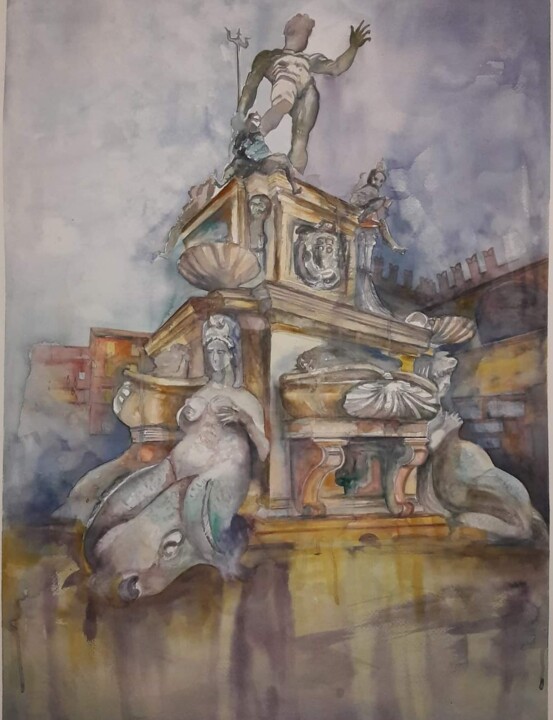
©2000 Daniela Devincenzi
Orígenes e Historia
Las Pinturas de Arte en la Tierra contemporáneas, también conocidas como Obras de la Tierra o Arte Ambiental, surgieron en los años 60 y 70 como una reacción contra la comercialización del arte y la urbanización de la sociedad.
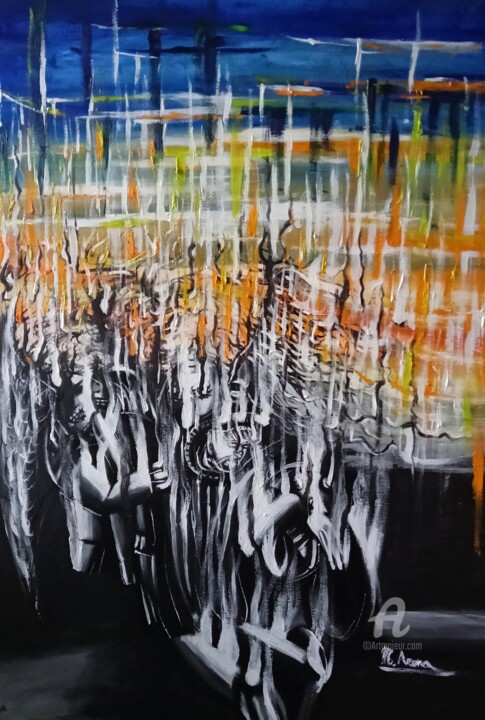
©2023 Mariaceleste Arena
Evoluciones de estas obras en el mercado de arte contemporáneo
Las Pinturas de Arte en la Tierra contemporáneas han evolucionado significativamente en los últimos años, con artistas que adoptan nuevas técnicas y perspectivas para crear obras más innovadoras e impresionantes. Estas pinturas a menudo presentan elementos naturales como rocas, tierra y plantas, y están diseñadas para ser exhibidas al aire libre en entornos naturales. Son particularmente importantes en el mercado del arte contemporáneo porque ofrecen una alternativa única y refrescante a formas más tradicionales de arte. Muchos coleccionistas y entusiastas del arte se sienten atraídos por las Pinturas de Arte en la Tierra porque ofrecen una conexión con la naturaleza y una sensación de tranquilidad que es difícil de lograr con otros tipos de arte. Además, las Pinturas de Arte en la Tierra a menudo son de gran escala, lo que las hace particularmente impresionantes y llamativas. Como tal, se han vuelto cada vez más populares en galerías y exposiciones de todo el mundo.
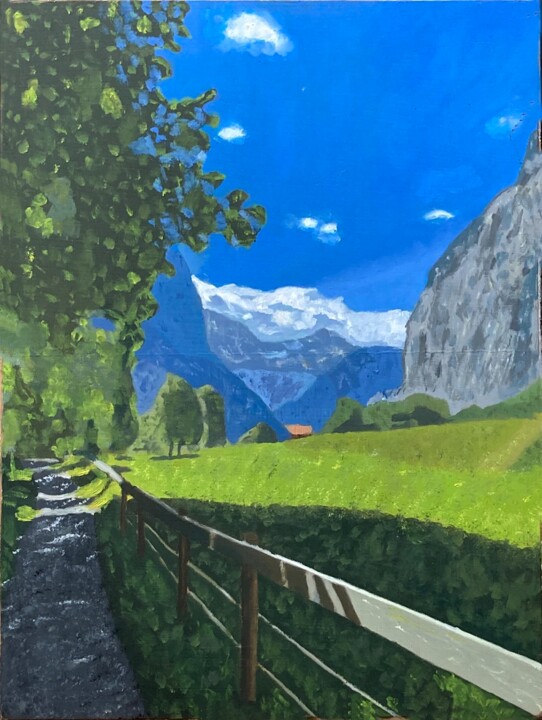
©2023 Cornelius Mugabi
Artistas Famosos Relacionados
Los Artistas Contemporáneos reconocidos por sus Pinturas de Arte en la Tierra contemporáneo incluyen a Richard Long, Andy Goldsworthy y Robert Smithson.
Richard Long es un artista británico famoso por sus obras que incorporan materiales naturales como piedras, ramas y barro. Sus obras suelen ser específicas del sitio e implican la creación de patrones y formas en el suelo. Las piezas de Long son conocidas por su simplicidad y su conexión con el mundo natural.
Andy Goldsworthy es un artista escocés conocido por sus obras efímeras que son creadas utilizando materiales naturales como hojas y ramitas. Las piezas de Goldsworthy a menudo involucran la creación de patrones y formas intrincados que son dejados para ser destruidos por los elementos. Sus obras son conocidas por su belleza delicada y su conexión con el mundo natural.
Robert Smithson fue un artista estadounidense conocido por sus instalaciones de Land Art a gran escala. Su obra más famosa es la Espiral Jetty, una bobina de rocas de 1.500 pies de longitud que sobresale en el Gran Lago Salado de Utah. Las obras de Smithson son conocidas por su ambiciosa escala y su capacidad para transformar el paisaje.
Otras consultas importantes relacionadas con las pinturas contemporáneas de Land Art incluyen el arte específico del sitio, el arte ambiental y las obras de tierra. Estos términos se utilizan a menudo para describir obras que son creadas y moldeadas por el entorno natural. Las pinturas contemporáneas de Land Art también están a menudo asociadas con el movimiento Land Art, que surgió en los años 60 y 70 como respuesta a la comercialización del mundo del arte.
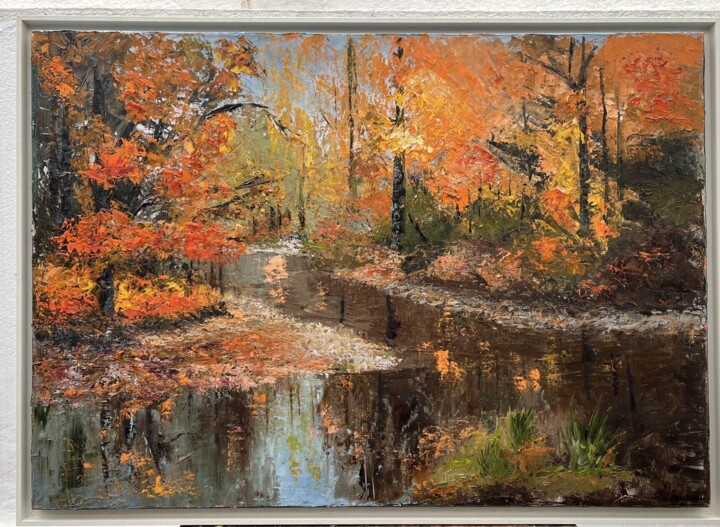
©2023 Nuria Candau
Pinturas de Arte Terrestre contemporáneo destacadas
Las Pinturas de Arte de Tierra Contemporáneo son una forma de arte que transforma los entornos naturales en un lienzo para la expresión de un artista. Aquí están algunas de las pinturas de arte de tierra contemporáneo más conocidas:
"Spiral Jetty" de Robert Smithson, 1970 Esta icónica obra de arte es una espiral de 1.500 pies de largo hecha de rocas y tierra que se extiende hacia el Gran Lago Salado en Utah. La obra de arte pretende ser un comentario sobre la relación entre el mundo natural y el hecho por el hombre.
"Broken Circle/Spiral Hill" de Robert Smithson, 1971 Otra obra de Robert Smithson, esta pieza consiste en un círculo roto hecho de rocas y una colina en espiral hecha de tierra. La obra de arte está ubicada en Emmen, Países Bajos, y pretende ser un comentario sobre la relación entre la naturaleza y la civilización.
"The Lightning Field" de Walter De Maria, 1977 Esta obra de arte consta de 400 postes de acero inoxidable que se disponen en un patrón de rejilla en una zona de un kilómetro de longitud en Nuevo México. Los postes pretenden atraer los rayos, creando una experiencia surrealista e irreal para los visitantes.
"Double Negative" de Michael Heizer, 1969 Esta obra de arte es un corte masivo en la tierra en el desierto de Nevada, que mide 1.500 pies de largo, 50 pies de profundidad y 30 pies de ancho. La obra de arte pretende ser un comentario sobre la naturaleza destructiva de la civilización humana.
"Spiral Hill" de Nancy Holt, 1971 Esta obra de arte consiste en una espiral hecha de tierra que se eleva en una colina en una zona remota de Utah. La obra de arte pretende ser un comentario sobre la naturaleza cíclica de la vida y la muerte.
Las pinturas contemporáneas de arte terrestre son una poderosa forma de conectarse con el mundo natural y explorar la relación entre la humanidad y el medio ambiente. Estas obras de arte son un testimonio del poder de la creatividad humana y la belleza del mundo natural.
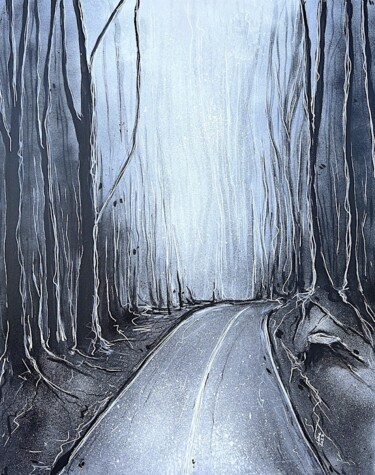
Nikol Valdman
Acrílico en Lienzo | 39,4x31,5 in
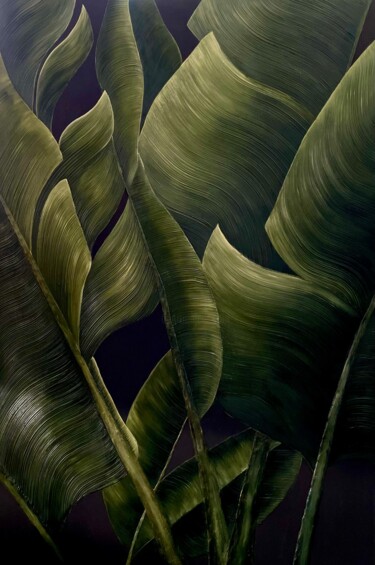
Natalya Nesterenko
Oleo en Lienzo De Lino | 47,2x31,5 in
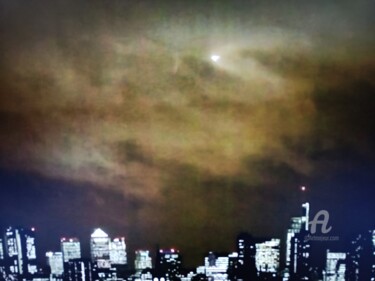
Ferrer Felicidad
Oleo en Lienzo De Lino | 25,6x39,4 in

Mariaceleste Arena
Acrílico en Lienzo
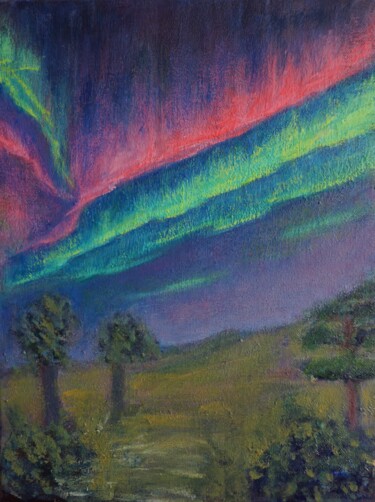
Galina Vasiljeva
Acrílico en Lienzo | 13,8x10,6 in
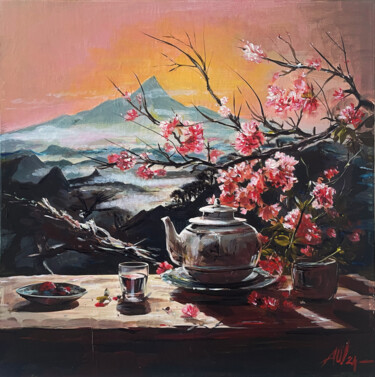
Amirata Winter
Acrílico en Cartulina | 11,8x11,8 in
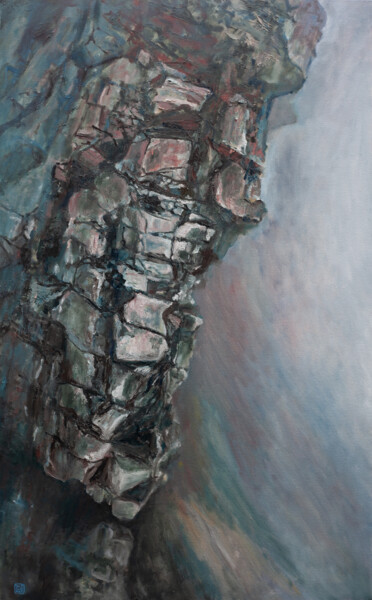
Liudmila Pisliakova
Oleo en Lienzo | 38,2x23,6 in
